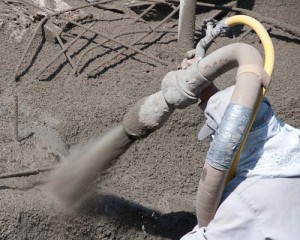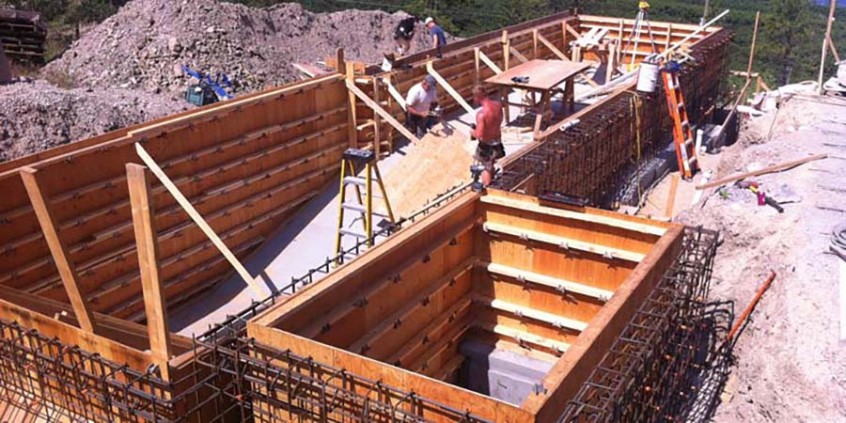When a client requests a concrete pool, spa, or water feature design, what they are essentially asking for is a vessel constructed of a mix comprising aggregate, sand, cement, and water that is placed over structural steel. One of the great benefits of designing a concrete vessel is the only limitation is the builder’s imagination. The execution of building the design may vary, and here begins the use, or possible misuse of terms that has continued for decades between pool designers, builders, and customers. Terms such as gunite, shotcrete, and cast-in-place, are used interchangeably and are all viable options in the construction of pools and spas. And, although each method used the same primary ingredients, each one is uniquely different.
Whether a pool is built using either one of the three methods mentioned above, in the end, it is constructed of steel and concrete and, therefore, it is a concrete pool. Customers often refer to their pool as a ‘gunite pool,’ or ‘shotcrete pool,’ although the placement technique and mix design vary, they are all concrete vessels.
Cast-in-place
Some of the top pool builders use this technique as part of their construction process, referring to similar technology used to build today’s contemporary skyscrapers with pinpoint accuracy. This technique requires skilled tradespeople to fabricate on-site forms and to place the ready-mix concrete in between the forms, while agitating it to remove any voids. Once the concrete sets, the forms are removed and the surface is prepared to receive the selected finishes (e.g. tile, stone, and/or cementitious coatings such as aggregate finishes). Other methods for cast-in-place vessels include the use of pre-fabricated panels that are connected, with concrete placed between them.
The use of cast-in-place to construct watertight vessels requires the use of various water-stop products, concrete additives, and waterproof membranes as multiple pours create cold joints (i.e. joints that are formed when two batches of concrete are placed at different intervals and the first batch, which has already been compacted, has started to set).
Understanding pool construction terms and techniques
Shotcrete
Shotcrete is a wet mix design that is applied pneumatically using a pump and hose. Shotcrete gets compacted as it is placed due to the velocity it is being delivered. It is reinforced by steel—as are all three methods—and is the proper term to be used when referring to pneumatically placing concrete. Although the term shotcrete is a verb, it is commonly used to define both wet-mix and dry-mix methods.
Shotcrete concrete is mixed in plant (similar to the cast-in-place method) where all ingredients, including water, are combined and put in a ready-mix truck to be delivered to the site. The mix is then placed in the hopper of a concrete pump, and with the use of air the concrete is pumped, via high velocity, through hoses and a shotcrete nozzle. The concrete is placed in layers in a back and forth motion to attain the desired shape and thickness. The shotcrete method is used in many diverse areas such as tunnels, bridges, and ground stabilization. Although not required, a certified-nozzle person is recommended as proper technique is critical in constructing a structurally sound and watertight vessel.
Gunite

Gunite nozzle operators use a back and forth motion to place the material in the desired shape and thickness, encapsulating the pool’s steel reinforcement.
Gunite is a form of concrete that is applied to a surface pneumatically, similar to shotcrete. The mix design for the gunite application is different; however, as it has a higher percentage of cement and a lower amount of water than the two previous methods. Like shotcrete, the formula results in a concrete mix that is dry enough to be applied to vertical surfaces such as pool walls.
Gunite concrete is often referred to as dry mix. The reason for this label is the dry nature of its application. Unlike cast-in-place or shotcrete, with gunite all the dry ingredients are mixed at a concrete plant, or at the jobsite, before it is applied. There is no water added to the dry concrete mix until it is applied via the gunite nozzle.
Gunite equipment forces the dry concrete mixture into a hose under air pressure. The dry mixture passes through the hose to a specialized gunite nozzle that is connected to a water source under pressure. The dry-mix design of all the ingredients is combined with the water and mixed through channels in the nozzle before being placed. The result is a concrete mixture that can be applied extremely dry with a high cement content to bind the aggregate with a very high comprehensive strength.
Understanding pool construction terms and techniques
As with shotcrete, gunite nozzle operators use a back and forth motion to place the material in the desired shape and thickness. Constructing pools and spas using gunite (dry mix) requires experienced personnel. It is critical to have sufficient-trained staff to place, carve, and finish the gunite structure.
When applied properly, the gunite technique can result in a stronger comprehensive strength than an installation completed with cast-in-place or shotcrete. The pounds per square inch strengths far exceed what would be required for a traditional backyard pool and spa.
Cementing it all together
Each and every project has a technique that is best suited to its design and engineering. For example, a rooftop pool would likely use the cast-in-place technique, where as a commercial lazy river would benefit from the shotcrete or gunite technique, or a combination of all three. In other situations, multiple techniques are used. The final decision on the vessel’s construction is based on multiple variables, such as cost, availability, and final design. Having the versatility to use more than one placement technique would benefit any company.
This article was written by Peter Vamvakaris and originally appeared on Pool & Spa Marketing [link].
